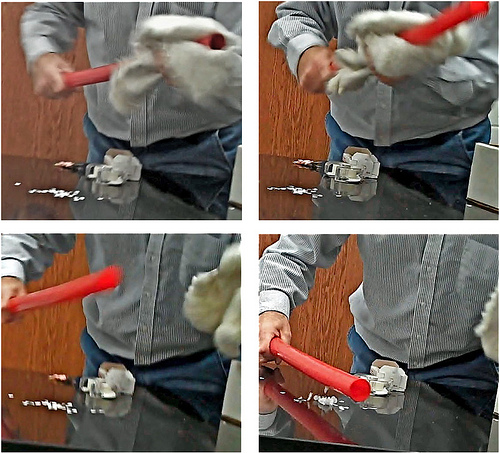Electrostatic Discharge
claimed by Dmcburnie3
Electrostatic Discharge (ESD) is the swift transfer of charges between objects at different potentials. ESD commonly occurs after the accumulation of static electricity on a material and can have devastating effects on solid-state electronics.
Material Sources of this Phenomenon
Both insulators and conductors are sources of ESD. All materials are defined on the Triboelectric series as either positive or negative, with positive and negative charges usually accumulating on naturally occurring surfaces and on synthetic materials, respectively. Sparks and lightning are visible Electrostatic Discharge events and the total amount of charge that can accumulate on a material depends on how well it can store charge. It is common for static electricity to accumulate on people and clothing in environments where sensitive electronic equipment must be protected. During the process in which electronic components are assembled most manufacturers implement create Electrostatic Discharge Protected Areas (EPA) for this work to be conducted in. These areas are to prevent the build up of charge on the components, workers, and all other conductive materials
Causes of Electrostatic Discharge
Electrostatic Discharge can be caused by an electrical breakdown, a short circuit, and most commonly, contact or near contact, due to tribocharging. Tribocharging is the separation of electric charges that occurs when objects make contact and then are separated. The Triboelectric method describes how this happens when materials are rubbed together (frictional movement) and separated. ESD is measured using an electrostatic voltmeter. To protect against Electrostatic Discharge, antistatic bags act as Faraday Cages to protect sensitive devices from ESD during the transit.
Its Effect on Electronics
ESD events, like a spark from a human hand, allow current to travel to the ground through electronic devices, burning holes in integrated circuits and dealing heat damage to the circuit board. This can happen when working barehanded (without an electrostatic wrist strap) with circuit boards and other sensitive electronic equipment, when negatively charged synthetic materials are on or near sensitive electronic equipment, or due to the fast movement of air near electronic equipment.
ESD in the Aerospace
Electrostatic Discharge is connected to Aerospace Engineering by how potentially dangerous it is to not guard against ESD in environment's in which many different electronic devices are integrated into air and spacecraft. Aerospace research agencies, such as NASA, JAXA, or RKA, and corporation, such as Lockheed Martin, have implemented ESD protected areas and grounded workbenches, mandated the use of protective equipment, introduced protocol in which charge generating materials cannot be worn in protected areas, and have audits and inspections to make sure important aerospace electronics stay protected from ESD.
The Physics Principals and Visual Aids
The objects near the top (of the list above) will tend to gain negative charges, while those below them will gain positive charges. The law of Conservation of Charge is followed.
First, a tube made out of plastic is charged when rubbed with synthetic fur (top pictures). The tube, which is now charged, is brought close to neutral paper bits on the table (bottom left). You can see that the tube and paper now attract each other and that this attraction is strong enough to lift the pieces of paper off the table.
See also
http://www.physicsbook.gatech.edu/Charge_Transfer
http://www.physicsbook.gatech.edu/Charge_Motion_in_Metals
http://www.physicsbook.gatech.edu/Polarization
https://en.wikipedia.org/wiki/Michael_Faraday
Further reading
Electro Static Discharge: Understand, Simulate, and Fix ESD Problems, 3rd Edition
External links
http://www.physicsclassroom.com/class/estatics/Lesson-2/Charging-by-Friction
References
Aaq.auburn.edu,. 'Summary | Academy Of Aerospace Quality'. N.p., 2015. Web. 5 Dec. 2015. (http://aaq.auburn.edu/node/277)
Michaels, Ken, AYMAN ZAHER, and Stan Herron. 'Electrostatic Discharge: Causes, Effects, And Solutions'. Ecmweb.com. N.p., 2013. Web. 6 Dec. 2015. (http://ecmweb.com/content/electrostatic-discharge-causes-effects-and-solutions)
Physicsclassroom.com,. 'Charging By Friction'. N.p., 2015. Web. 6 Dec. 2015. (http://www.physicsclassroom.com/class/estatics/Lesson-2/Charging-by-Friction)

